Featured
- Get link
- X
- Other Apps
Designing Your Dream Home: Creating a Cohesive Color Scheme Throughout Your Space
Color is one of the most important elements of interior design, as it can set the tone for an entire room or home. Choosing the right colors can create a sense of balance, harmony, and visual interest that can transform a space into a beautiful and inviting oasis. However, with so many color options available, it can be overwhelming to know where to start. In this blog, we will explore the key principles of creating a cohesive color scheme throughout your home, and provide tips and tricks to help you choose the perfect palette for your space.
Understand the Basics of Color Theory
Before diving into color selection, it’s important to understand the basics of color theory. The color wheel is a helpful tool that can guide your color selection process. It is comprised of primary colors (red, blue, and yellow), secondary colors (green, orange, and purple), and tertiary colors (yellow-green, blue-green, red-orange, etc.). When selecting colors, consider their relationship to one another on the color wheel.
Complementary colors are opposite each other on the wheel, such as blue and orange or red and green. These colors create high contrast and can add energy to a space. Analogous colors are next to each other on the wheel, such as blue and green or orange and yellow. These colors create a sense of harmony and cohesion. Monochromatic colors are variations of the same hue, such as light blue, sky blue, and navy blue. This creates a subtle, soothing color scheme.
Choose a Dominant Color
Once you understand the basics of color theory, it’s time to choose a dominant color for your space. This color will set the tone for your entire home and will be the primary color in your color scheme. It can be helpful to choose a neutral color as your dominant color, such as white, beige, or gray, as this can create a calming and versatile backdrop for the rest of your decor. If you prefer bolder colors, consider choosing a deep navy blue or forest green as your dominant color.
Select Accent Colors
Once you have chosen your dominant color, it’s time to select accent colors. These colors should complement your dominant color and create visual interest in your space. You can use the color wheel to choose complementary or analogous colors, or choose colors that are found in nature, such as warm earth tones or cool ocean blues. Consider using accent colors in pillows, artwork, rugs, and other decorative accessories to create a cohesive look throughout your space.
Consider Your Lighting
Lighting can have a significant impact on the way colors appear in your space. Natural light can bring out the true colors in your decor, while artificial light can cast a yellow or blue tint. When selecting your color scheme, consider the type of lighting in your space and how it will affect the colors you choose. You may need to adjust your color palette to accommodate for lighting conditions.
Use Color to Define Zones
Color can be used to define different zones within an open-concept space. For example, you can use one color for your living area and a different color for your dining area. This can create a sense of separation between the zones while still maintaining a cohesive look throughout your home.
Don’t Be Afraid to Experiment
Choosing a color scheme for your home can be intimidating, but don’t be afraid to experiment with different colors and patterns. Consider using bold wallpaper, colorful tile backsplash, or vibrant artwork to add personality to your space. Remember, the goal is to create a space that reflects your personal style and makes you feel at home.
- Get link
- X
- Other Apps
Popular Posts
The Power of Texture: Layering Materials for a Luxurious Look
- Get link
- X
- Other Apps
Mastering the Art of Mixing Patterns in Home Decor
- Get link
- X
- Other Apps


Comments
Post a Comment